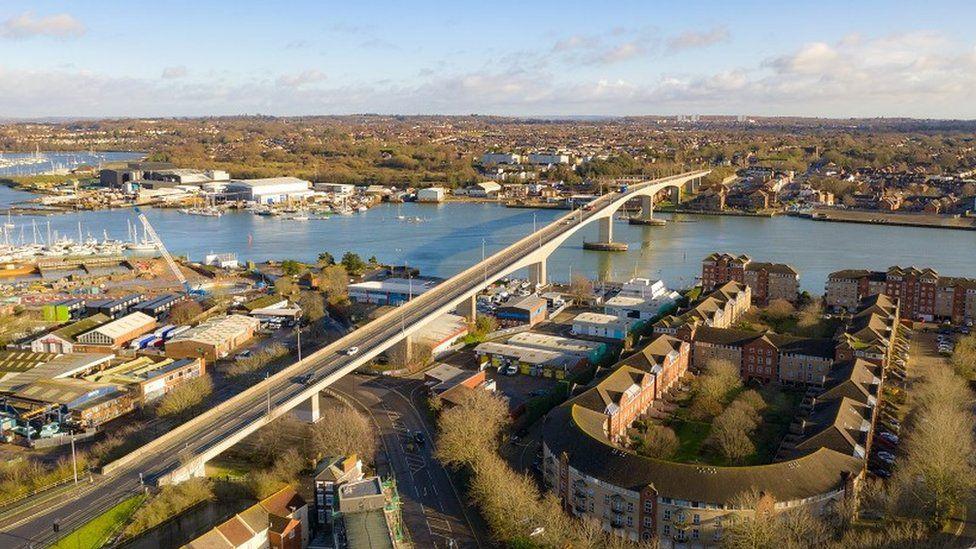The Road West
In medieval times, the route west from Southampton led north through the Bargate, then followed Regent Street to the shore.
Here, Canshut Lane travelled first north-westwards, then west along Western Shore to Achards Bridge, which carried on over the Rolles Brook, now found in Rollesbrook Valley Greenway.
Achards Bridge was also called Hill Bridge, from the nearby Village and Lane, or Four Posts Bridge; it marked the westward limit of the town’s liberties, and carried four direction vanes.
Four Posts Hill fed into Millbrook Road, and the (Old) Redbridge Road, to cross the River Test in Redbridge.

Commercial Road was constructed to improve this route in 1791 - it was originally a toll road, with a toll bar in Above Bar Street - later known as The Junction, because tram routes met up there. It superseded the Canshut Lane route as far as Four Posts Hill.
Part of the area between this route and the waterside was used by the railway, but there was little change until the 1930s, when Western Bay was enclosed.
The road west then became much further inland and the route was replaced by Western Esplanade and Mountbatten Way in the late 1970s.
Roundabouts and flyovers have improved the traffic flow, though not the view, and a new bridge carries the A33 over the River Test in Redbridge.
The Road North
For many years there was no road leading north past Southampton Common except for a cattle drove, and the route to London lay along London Road, then Rockstone Lane and Portswood Road to Winchester, and afterwards through Alresford, Farham and Esher to Kingston. This route is commemorated in the sign about coaches still to be seen outside the Star Hotel in High Street, and is now the A31 and A3
It is hard to find a time when The Avenue started to be used as the main road to Winchester, but Southampton Corporation sought to enhance its appearance during the Spa period, to make it more attractive to visitors.

During the Mayoralty of Arthur Atherton in 1745, trees were planted along its entire length. It became much improved by becoming a toll road in 1758.
In 1849, Philip Brannon described the Avenue as: “one of the greatest ornaments to the town, which gave a most favourable impression to visitors.”
The route to London from the north end of the Avenue still ran up the A31 and the A3 for many years, but was later superseded by the M3, with the final stretch opening in 1993.
The Road East
The road east always meant crossing the Itchen, and from time immemorial, that was by a rowed ferry, from Cross House Hard to Itchen Ferry Village.
To reach this ferry, one would leave Gods House Tower and walk east to Cross House Hard.
Pitt’s Lane ran eastwards from south of Holyrood - it would have been a direct route to the Ferry but was blocked by the Town Walls. In the 18th century, it was extended through the walls, and a rope bridge was built over the town ditch.
It was widened in 1807, and re-named Bridge Street. Soon after, a stone bridge was built to replace the old rope bridge, and the road from that stone bridge east became Bernard Street. This name was taken from builders Thomas and Peter Bernard, who settled in Southampton in 1800, and constructed many properties in the area.

In the mid-1800s, in order to reach Portsmouth, horses, carts and coaches had to go north to Northam Bridge and pay tolls.
November 23 1836, the Floating Bridge commenced operations.
The eastern part of the road was then re-named Bridge Road, leading to Lower Bridge Road and then Floating Bridge Road, which still survives.
The Floating Bridge was replaced by the Itchen Bridge – ironically still a toll bridge – on June 11, 1977, finally creating a direct route to the east.

Jack Wilson is a tour guide with SeeSouthampton.co.uk .












Comments: Our rules
We want our comments to be a lively and valuable part of our community - a place where readers can debate and engage with the most important local issues. The ability to comment on our stories is a privilege, not a right, however, and that privilege may be withdrawn if it is abused or misused.
Please report any comments that break our rules.
Read the rules hereLast Updated:
Report this comment Cancel